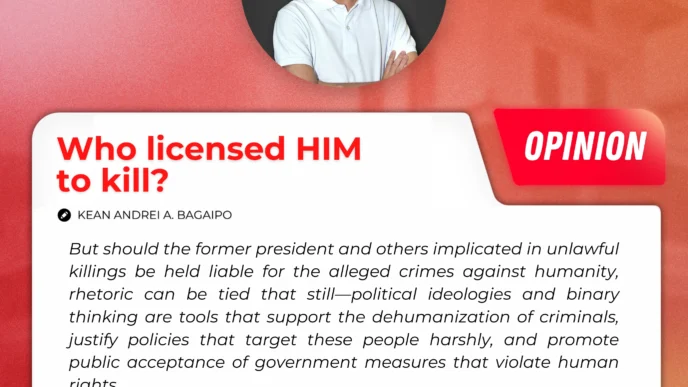By Deorafe T. Basong
I remember an old, stunted plant in our backyard. It has been there for years, but it has never grown into a full-fledged tree because it is pathetically located in a crack between two boulders. Its location never gives the plant enough soil or water to achieve its possible proportions. It remains there—a curled and stunted miniature of what it can possibly become.
We can be so stunted in our capacity to grow and care for another because of the amount of education we receive as learners. John Powell wrote, “Our lives are oftentimes shaped by those who have loved us or refused to love us earlier in life.” If we do not willfully break out of these confines, we could be broken, isolated, and “miniature” through life. Strange that later in life, our deeper sense of “Via, Veritas, Vita” will spring from this activity of forging and building relationships in the community we soon serve.
Every facet of student life is deeply grounded in the desire to serve the community. Its importance has been embraced by every Sillimanian as being equally vital to academic success. For 123 years now, Silliman University has remained faithful to its vision of “total human development for the well-being of society and environment.” The social awareness and skills that we acquire in the classroom help us build resilience and create the groundwork for strengthening our quest to serve others for the rest of our lives. There are several dimensions of “Via, Veritas, Vita.” Yet a more profound form of these is living in a way where “academic learning and Christian faith are anchored on the gospel of Jesus Christ.”
Every Sillimanian believes that excellence is at the heart of a vibrant society and an essential foundation for a thriving future for Silliman, the country, and the world. The present educational policies and standards of Silliman University serve as indispensable catalysts to the development of skills needed to cope with the complexities of contemporary multicultural societies and qualify for jobs in the fast-growing local and transnational industries. Silliman’s academic programs reinforce the foundations of these industries and strengthen the capabilities of its educators in teaching well-grounded students who are equipped with necessary skills vertically aligned to their chosen fields of discipline. Through interdisciplinary and multimodal approaches in the academe, Silliman hones its students’ ability to articulate their understanding of the world outside the perimeters of the school.
One thing that goes hand in hand with sustaining Silliman’s gifts is the fact of challenges. When Dumaguete City achieves progressive tourism growth, we wish it to be sustainable, so that future generations may still enjoy a healthy and balanced ecology while preserving Silliman’s treasures and gifts. This tourism growth alone already involves the risk of educational imbalance and loss of interest in education by the youth sector. Sadly, after High School, some succumbed to the inviting jobs brought about by tourists and forgot about pursuing a college education. More risks are involved when one goes deeper into transforming today’s treasures into tomorrow’s traditions. It might be a risk of losing the pristine white sand beach we used to trek, or the risk of being engulfed with natural tragedies for the indiscriminate cutting down of trees and expanding coastal reclamations, or the risk of getting tied down with economic wealth at the expense of the environment. Ultimately, all these risks are associated with a lack of education. Yet something inside propels us to shoot the rapids in spite of the risks involved. We could get bruised, humbled by nature’s wrath, or bloodied after destroying Mother Nature, but Silliman’s desire to preserve the archipelago as a naturally crafted piece of art is triumph enough.
One routine I was accustomed to when I spent summer in my hometown was a walk on a three–kilometer stretch of a white pristine beach near the house. Each morning, I trekked that stretch of sand. I know the sand has been there for decades now. The sand has achieved a degree of permanence as it is constantly washed by the breakwater. Yet, in the face of permanence, I noticed that every morning something changed – the sand had shifted a little on this point overnight, that driftwood was not on that spot yesterday, and those rocks were not yet exposed a week ago.
That day felt like a beautiful memory, and I realized right then that I had a gift to find art even in the most familiar objects. I thought I was weird. I saw things differently. The familiar sands of my home turf are much like the familiar culture and history of Silliman University. From the artist’s point of view, it is filled with beauty and wonder. For some, it’s dull and boring. A foreign tourist appreciates every piece of the country’s natural wonders as “perla del mar del oriente” or pearl of the orient seas, while some islanders destroy the natural balance of the ecosystem much to the whims of economic ambitions.
Celebrating Silliman’s gifts is a painstaking process, yet it means growth. We do not grow if we are afraid to inquire about things that make us a better community. We do not grow if we do not learn to take the risks of trying to sustain our lives through education. We hinder our desire to serve if we keep clinging to our familiar notions of the known and the secure. The more challenges Silliman overcomes, the more it has lived its mission to the fullest. The more obstacles its students conquer, the better they understand commitment in “Via, Veritas, Vita”. For life, as in Silliman University, is a package deal of sweet grapes and bitter almonds, of new heights attained and rugged cliffs scaled. As Colleen McCullough puts it, “the best of things is bought at the cost of great suffering.”




